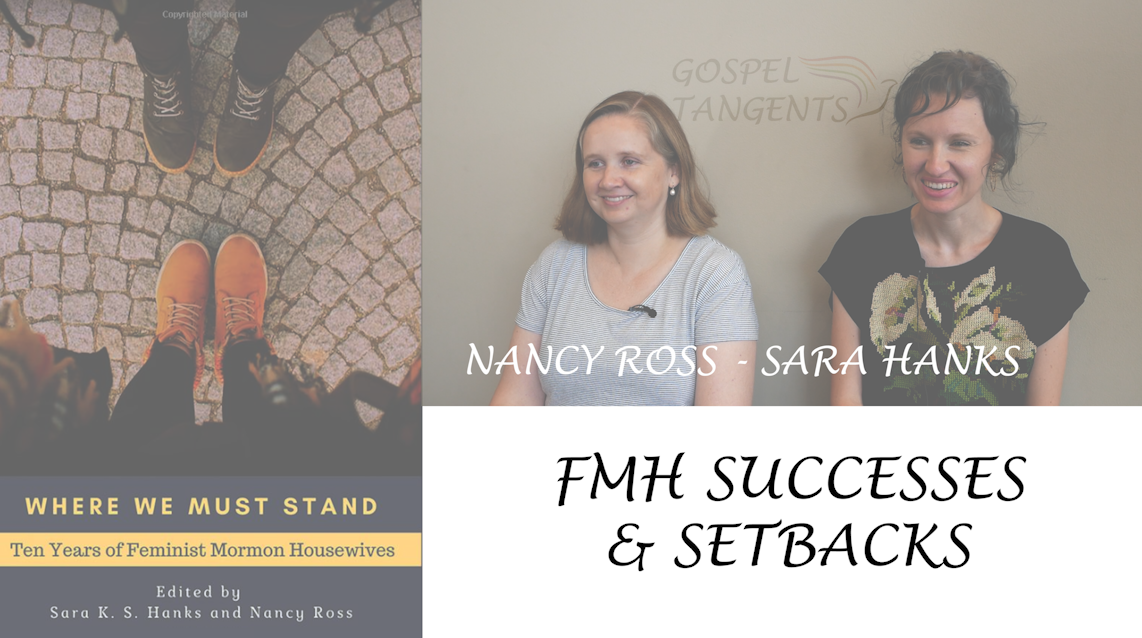Dr. Nancy Ross and Sara Hanks, co-authors of “Where We Must Stand” discuss their experiences blogging at Feminist Mormon Housewives, and putting together a book on the first 10 years of the blog. They discusses some of the feminist successes & setbacks between 2012-2014. What were some of the successes in pushing for change within the LDS Church?

Nancy:But at that time the community was all about activism, or so much of the community conversation turned to activism. Really. In the middle of 2012, and this is covered in the book, there’s a little activist action to try and better understand different temples’ policies with regard to women and young women doing baptisms for the dead while menstruating. And so, there are a bunch of phone calls made and they try to get information about what different temples policies are with the idea that, you might show up at a temple and they might have a different policy and that might make people feel excluded or embarrassed.
Sara: Embarrassed. Yeah.
Nancy: And so that happens in the middle of 2012. By the end of 2012, we’ve got the first “Wear pants to church day,” and then that’s followed by, “Let Women Pray,” and the advent of “Let Women Pray was it’s own activist event to try and ask church leaders to let a woman pray in general conference which happened with Jean Stephens, which is super exciting.
Sara: Yeah.
Nancy:And then we’ve got the arrival of Ordain Women in the Spring of 2013. And so leading up to Kate Kelly’s excommunication, like from the middle of 2012 to the middle of 2014, there was just so much momentum in the community for like, Hey, we can change things. With the temple baptisms issue after all of this information gathering, someone was able to kind of make a connection further up the chain in the church and then the church issued a clarification to say no, we need all the temples to allow women young women to participate in baptisms regardless of whether or not they’re menstruating. And that was, that felt huge.
Concerning Kate Kelly’s excommunicationin 2014,
Sara: One part of the feeling was just so much shock, because not only had we felt really hopeful for the possibilities of change, but we also kind of were under the impression as a community at large that with the advent of the Internet and so much attention being paid to the church and so much possibility for exposing problems or injustices that the church wouldn’t take the sort of actions that they had taken when it came to Sonia Johnson in the 70’s or the September Six in the early 90’s or the, the professors at BYU who were censured. We thought, “They wouldn’t because it would be too much of a risk. There would be too much backlash.”
Nancy: And it was also right in the middle of that Mormon moment. And the church had done the “I’m a Mormon” campaign. They had spent so much time, effort, energy and resources trying to make the church look good in the eyes of the public.
Check out our conversation…
 Co-authors Sara Hanks, and Dr. Nancy Ross discuss their book “Where We Must Stand: Ten Years of Feminist Mormon Housewives.”
Co-authors Sara Hanks, and Dr. Nancy Ross discuss their book “Where We Must Stand: Ten Years of Feminist Mormon Housewives.”
You might want to check out our other conversations on Women’s studies.
189: Women Have Had Priesthood since 1843! (Quinn)
165: Elder Oaks Groundbreaking Talk on Women & Priesthood(Stapley)
164: The Mormon Priestess & Ordain Women (Stapley)
163: Women Healers in LDS Temples (Stapley)
134: Role of Women in 4 American Religions (Bringhurst)
066: Women Will Not Hold Priesthood! (Vun Cannon)
049: Mormon Polyandry: More Than One Husband? (Hales)
Podcast: Play in new window | Download (Duration: 20:34 — 19.0MB) | Embed
Subscribe: Email | | More
